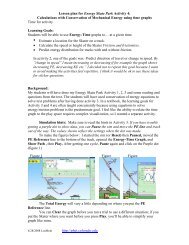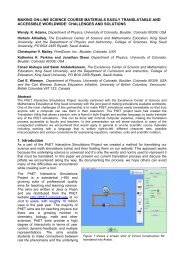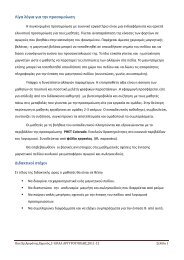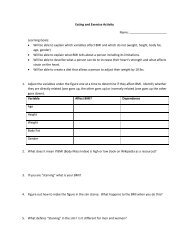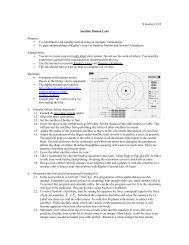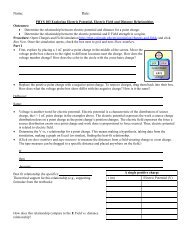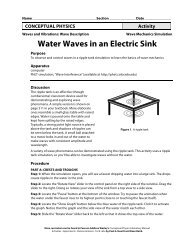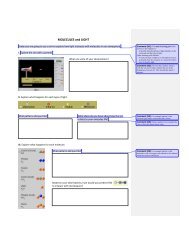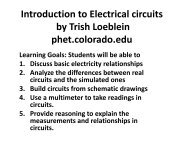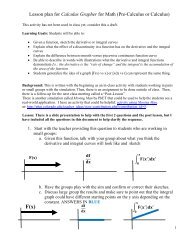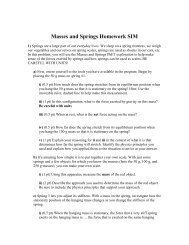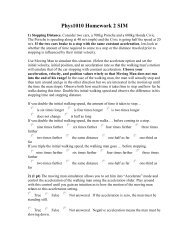clicker questions for sound.pdf - PhET
clicker questions for sound.pdf - PhET
clicker questions for sound.pdf - PhET
You also want an ePaper? Increase the reach of your titles
YUMPU automatically turns print PDFs into web optimized ePapers that Google loves.
Sound activity<br />
I used <strong>questions</strong> 1-8 with the <strong>sound</strong> activity<br />
and the rest on the next day.
1. A student started the speaker by<br />
clicking on the stopwatch. How<br />
many <strong>sound</strong> waves are there is this<br />
trial<br />
A. 3<br />
B. 5<br />
C. 4<br />
D. 8
2. What is the speed of the<br />
<strong>sound</strong> waves shown here<br />
A. 300 m/s<br />
B. 330 m/s<br />
C. 0.0030 m/s<br />
D. 66 m/s
3. What is the frequency of the<br />
<strong>sound</strong> waves shown here<br />
A. 0.0037 hz<br />
B. 66 hz<br />
C. 260 hz<br />
D. 300 hz<br />
E. 330 hz
4. What is the period of the<br />
<strong>sound</strong> waves shown here<br />
A. 0.0151 s<br />
B. 0.0037 s<br />
C. 260 s<br />
D. 300 s<br />
E. 330 s
5. What is the wavelength of the<br />
<strong>sound</strong> waves shown here<br />
A. 5 m<br />
B. 1.3 m<br />
C. 1 m<br />
D. 0.71 m<br />
E. 300 m
6. If your lab partner moved the<br />
frequency slider to the left so<br />
that it changed from 500 to 250<br />
the period would be<br />
A. twice as big<br />
B. 1/2 as big<br />
C. Stays the same<br />
D. 1/4 times as big<br />
E. Not enough in<strong>for</strong>mation to decide
7. If you moved the slider to the<br />
far right, doubling the<br />
amplitude,<br />
the period would be…<br />
A. twice as big<br />
B. 1/2 as big<br />
C. Stays the same<br />
D. 1/4 times as big<br />
E. Not enough in<strong>for</strong>mation to decide
Sound waves traveling out<br />
8. If the speaker vibrates back and <strong>for</strong>th at<br />
200 Hz how much time passes between each<br />
time it produces a maximum in pressure<br />
a. 0.2 seconds<br />
b. 0.200 seconds<br />
c. 0.005 seconds<br />
d. 0.02 seconds<br />
e. 0.05 seconds
9.A speaker is playing a constant note.<br />
What happens to the <strong>sound</strong> when you<br />
1) put a solid, thick glass jar over it and<br />
2) pump the air out from the jar.<br />
A) 1 => hardly any difference<br />
2 => hardly any difference<br />
B) 1=> hardly any difference<br />
2 => much quieter<br />
C) 1=> noticeably quieter<br />
2 => hardly any MORE quiet<br />
D) 1=> noticeably quieter<br />
2=> much quieter still (near silence)<br />
E) None of these/something else/
10. If you could put a dust<br />
particle in front of the speaker.<br />
Which choice below shows the<br />
motion of the dust particle<br />
A) (up and down)<br />
B) (steadily to the right)<br />
dust<br />
C) (left and right)<br />
D) (no motion)<br />
E) (circular path)
11.The picture shows “displacement as a<br />
function of location along a string”<br />
What is the wavelength (“λ”)<br />
C<br />
B<br />
D<br />
E none of these<br />
A<br />
Remember X axis is position<br />
not time<br />
Fundamentals of waves
12.The picture shows “displacement as a<br />
function of location along a string”<br />
What is the amplitude<br />
C<br />
B<br />
D<br />
E none of these<br />
A<br />
Remember X axis is position<br />
not time<br />
Fundamentals of waves
13.Looking at the following wave<strong>for</strong>m,<br />
what is the period assume it repeats itself<br />
over and over<br />
1 2<br />
time (sec)<br />
A.1 sec<br />
B. 2 sec<br />
C. 1 m/s<br />
D. 2 m/s<br />
E.Not enough in<strong>for</strong>mation
14 Looking at that same wave,<br />
what is its speed<br />
1 2<br />
Time (sec)<br />
A.1/2 m/s<br />
B.2 m/s<br />
C.5 m/s<br />
D.20 m/s<br />
E.Not enough in<strong>for</strong>mation
CT 2.1.10<br />
15 The wavelength, λ, is 10 m. What is the<br />
speed of this wave<br />
1<br />
Time (sec)<br />
A) 1 m/s<br />
B) just under 7 m/s<br />
C) 10 m/s<br />
D) 15 m/s<br />
E) None of the above/not enough info/not sure
CT 2.2.3<br />
16 What is the period of this wave<br />
Amp<br />
t=0 t 1<br />
t 2<br />
time<br />
a) t 1<br />
b) t 2<br />
c) Not at all defined<br />
d) Not well defined, but t 1 is the best answer<br />
e) Not well defined, but t 2 is the best answer
17 What is the period of this wave<br />
Amp<br />
0<br />
t 1 t 2 t 3<br />
time<br />
t 4<br />
a) t 1<br />
b) t 2<br />
c) t 2 -t 1<br />
d) t 3 -t 1<br />
e) None of the above
18 Which one of the following is most likely to<br />
be impossible<br />
A. Transverse waves in a gas<br />
B. Longitudinal waves in a gas<br />
C. Transverse waves in a solid<br />
D. Longitudinal waves in a solid<br />
E. They all seem perfectly possible
19. To increase the volume of a tone at<br />
400 Hz heard by the listener, the<br />
speaker must oscillate back and <strong>for</strong>th<br />
more times each second than it does to<br />
produce the tone with lower volume.<br />
A. True B. False
In the following graph we have plotted the<br />
pressure measured at the listener’s ear as a<br />
function of time <strong>for</strong> a 200 Hz tone<br />
generated by the speaker.
20. Which of the blue solid curves could<br />
represent the curve <strong>for</strong> a lower pitch
21. Which of the blue curves could represent<br />
the curve <strong>for</strong> a louder volume
22. Which of the blue curves could<br />
represent the curve if the speaker settings<br />
are unchanged, but the listener is further



